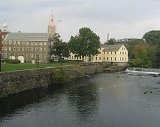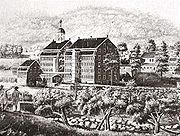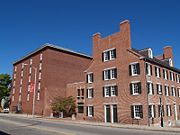
Waltham-Lowell system
Encyclopedia
Waltham-Lowell System was a labor and production model employed in the United States, particularly in New England
, during the early years of the American textile industry
in the early 19th Century.
Made possible by inventions such as the spinning jenny
, spinning mule
, and water frame
in England around the time of the American Revolution
, the textile industry was among the earliest mechanized industries, and models of production and labor sources were first explored here.
Before industrialization, textile production was typically done at home, and early industrial systems such as Samuel Slater
's Rhode Island System maintained housing for families, with only spinning done in the factory. Weaving was "put out
" to surrounding villagers. The Waltham-Lowell System saw all stages of textile production done under one roof, with employees living in company housing, and away from home and family.
The system used domestic labor, often referred to as mill girls, who came to the new textile centers from rural towns to earn more money than was possible at home, and to live a cultured life in "the city". They lived a very regimented life - they lived in company boardinghouses and were held to strict hours and a rigid moral code.
As competition in the domestic textile industry increased and wages subsequently fell, strikes began to occur, and with the introduction of cheaper imported foreign workers by mid-century, the system proved unprofitable and declined.
 The precursor to the Waltham-Lowell system was seen in Rhode Island
The precursor to the Waltham-Lowell system was seen in Rhode Island
, where British immigrant Samuel Slater
set up his first spinning mills in the 1790s.
Slater drew on his British village experience to create a factory system called the "Rhode Island System," based upon the customary patterns of family life in New England villages. Children aged 7 to 12 were the first employees of the mill; Slater personally supervised them closely. The first child workers were hired in 1790. It is highly unlikely that Slater resorted to physical punishment, relying on a system of fines. Slater first tried to staff his mill with women and children from far away, but that fell through due to the close-knit framework of the New England family. He then brought in whole families, creating entire towns.. He provided company-owned housing nearby, along with company stores; he sponsored a Sunday School where college students taught the children reading and writing.
 After the successes of Samuel Slater, a group of investors today known as The Boston Associates
After the successes of Samuel Slater, a group of investors today known as The Boston Associates
and led by Newburyport, Massachusetts
merchant Francis Cabot Lowell devised a new textile operation on the Charles River
in Waltham, Massachusetts
, west of Boston
. This new firm, the first in the nation to place cotton-to-cloth production under one roof, was incorporated as the Boston Manufacturing Company
in 1814.
The Boston Associates attempted to create a well-controlled system of labor which varied from the harsh conditions observed while in Lancashire
, England. The mill owners recruited young New England farm girls from the surrounding area to come work the machines at Waltham. The mill girls, as they came to be known, lived in boarding houses provided by the company and were supervised by older women, and were subject strict codes of conduct. They worked approximately eighty hours per week. The workers would wake to the factory bell at 4:40 in the morning. They would report to work at 5:00 and have a half hour breakfast break at 7:00 a.m. They would then work until the half hour to forty-five minute lunch break at noon. At 7:00 p.m. the factory would shut down and the workers would return to their company houses. This routine was followed six days a week. This system became known as the Waltham System.
 While the Boston Manufacturing Company proved immensely profitable, the Charles River had very little potential as a power source. Lowell died prematurely in 1817, and shortly afterwards, his partners traveled north of Boston to East Chelmsford, Massachusetts
While the Boston Manufacturing Company proved immensely profitable, the Charles River had very little potential as a power source. Lowell died prematurely in 1817, and shortly afterwards, his partners traveled north of Boston to East Chelmsford, Massachusetts
, where the large Merrimack River
could provide far more power. The first mills, the Merrimack Manufacturing Company
, were running by 1823. The settlement was incorporated as the town of Lowell in 1826, and became the city of Lowell ten years later. Boasting ten textile corporations, all running on the Waltham System and each considerably larger than the Boston Manufacturing Company, Lowell became one of the largest cities in New England and the model, now known as the Lowell System, was copied elsewhere in New England, often in other mill towns developed by the Boston Associates. Examples include Manchester, New Hampshire
; Lewiston, Maine
; Lawrence, Massachusetts
; and Holyoke, Massachusetts
.
New England
New England is a region in the northeastern corner of the United States consisting of the six states of Maine, New Hampshire, Vermont, Massachusetts, Rhode Island, and Connecticut...
, during the early years of the American textile industry
Textile industry
The textile industry is primarily concerned with the production of yarn, and cloth and the subsequent design or manufacture of clothing and their distribution. The raw material may be natural, or synthetic using products of the chemical industry....
in the early 19th Century.
Made possible by inventions such as the spinning jenny
Spinning jenny
The spinning jenny is a multi-spool spinning frame. It was invented c. 1764 by James Hargreaves in Stanhill, Oswaldtwistle, Lancashire in England. The device reduced the amount of work needed to produce yarn, with a worker able to work eight or more spools at once. This grew to 120 as technology...
, spinning mule
Spinning mule
The spinning mule was a machine used to spin cotton and other fibres in the mills of Lancashire and elsewhere from the late eighteenth to the early twentieth century. Mules were worked in pairs by a minder, with the help of two boys: the little piecer and the big or side piecer...
, and water frame
Water frame
The water frame is the name given to the spinning frame, when water power is used to drive it. Both are credited to Richard Arkwright who patented the technology in 1768. It was based on an invention by Thomas Highs and the patent was later overturned...
in England around the time of the American Revolution
American Revolution
The American Revolution was the political upheaval during the last half of the 18th century in which thirteen colonies in North America joined together to break free from the British Empire, combining to become the United States of America...
, the textile industry was among the earliest mechanized industries, and models of production and labor sources were first explored here.
Before industrialization, textile production was typically done at home, and early industrial systems such as Samuel Slater
Samuel Slater
Samuel Slater was an early English-American industrialist known as the "Father of the American Industrial Revolution", or the "Father of the American Factory System" because he brought British textile technology to America. He learned textile machinery as an apprentice to a pioneer in the British...
's Rhode Island System maintained housing for families, with only spinning done in the factory. Weaving was "put out
Putting-Out system
The putting-out system was a means of subcontracting work. It was also known as the workshop system. In putting-out, work was contracted by a central agent to subcontractors who completed the work in their own facilities, usually their own homes....
" to surrounding villagers. The Waltham-Lowell System saw all stages of textile production done under one roof, with employees living in company housing, and away from home and family.
The system used domestic labor, often referred to as mill girls, who came to the new textile centers from rural towns to earn more money than was possible at home, and to live a cultured life in "the city". They lived a very regimented life - they lived in company boardinghouses and were held to strict hours and a rigid moral code.
As competition in the domestic textile industry increased and wages subsequently fell, strikes began to occur, and with the introduction of cheaper imported foreign workers by mid-century, the system proved unprofitable and declined.
The Rhode Island System

Rhode Island
The state of Rhode Island and Providence Plantations, more commonly referred to as Rhode Island , is a state in the New England region of the United States. It is the smallest U.S. state by area...
, where British immigrant Samuel Slater
Samuel Slater
Samuel Slater was an early English-American industrialist known as the "Father of the American Industrial Revolution", or the "Father of the American Factory System" because he brought British textile technology to America. He learned textile machinery as an apprentice to a pioneer in the British...
set up his first spinning mills in the 1790s.
Slater drew on his British village experience to create a factory system called the "Rhode Island System," based upon the customary patterns of family life in New England villages. Children aged 7 to 12 were the first employees of the mill; Slater personally supervised them closely. The first child workers were hired in 1790. It is highly unlikely that Slater resorted to physical punishment, relying on a system of fines. Slater first tried to staff his mill with women and children from far away, but that fell through due to the close-knit framework of the New England family. He then brought in whole families, creating entire towns.. He provided company-owned housing nearby, along with company stores; he sponsored a Sunday School where college students taught the children reading and writing.
Waltham

The Boston Associates
The Boston Associates was a term created by historian Vera Shlakmen in Economic History of a Factory Town, A Study of Chicopee, Massachusetts to describe a loosely linked group of investors. They included Nathan Appleton, Patrick Tracy Jackson, Abbott Lawrence, and Amos Lawrence, often related...
and led by Newburyport, Massachusetts
Newburyport, Massachusetts
Newburyport is a small coastal city in Essex County, Massachusetts, United States, 35 miles northeast of Boston. The population was 21,189 at the 2000 census. A historic seaport with a vibrant tourism industry, Newburyport includes part of Plum Island...
merchant Francis Cabot Lowell devised a new textile operation on the Charles River
Charles River
The Charles River is an long river that flows in an overall northeasterly direction in eastern Massachusetts, USA. From its source in Hopkinton, the river travels through 22 cities and towns until reaching the Atlantic Ocean at Boston...
in Waltham, Massachusetts
Waltham, Massachusetts
Waltham is a city in Middlesex County, Massachusetts, United States, was an early center for the labor movement, and major contributor to the American Industrial Revolution. The original home of the Boston Manufacturing Company, the city was a prototype for 19th century industrial city planning,...
, west of Boston
Boston
Boston is the capital of and largest city in Massachusetts, and is one of the oldest cities in the United States. The largest city in New England, Boston is regarded as the unofficial "Capital of New England" for its economic and cultural impact on the entire New England region. The city proper had...
. This new firm, the first in the nation to place cotton-to-cloth production under one roof, was incorporated as the Boston Manufacturing Company
Boston Manufacturing Company
The Boston Manufacturing Company was organized in 1813 by Francis Cabot Lowell, a wealthy Boston merchant, in partnership a group of investors known as The Boston Associates, for the manufacture of cotton textiles. Boston Manufacturing Company gathered many of their trade secrets from the earlier...
in 1814.
The Boston Associates attempted to create a well-controlled system of labor which varied from the harsh conditions observed while in Lancashire
Lancashire
Lancashire is a non-metropolitan county of historic origin in the North West of England. It takes its name from the city of Lancaster, and is sometimes known as the County of Lancaster. Although Lancaster is still considered to be the county town, Lancashire County Council is based in Preston...
, England. The mill owners recruited young New England farm girls from the surrounding area to come work the machines at Waltham. The mill girls, as they came to be known, lived in boarding houses provided by the company and were supervised by older women, and were subject strict codes of conduct. They worked approximately eighty hours per week. The workers would wake to the factory bell at 4:40 in the morning. They would report to work at 5:00 and have a half hour breakfast break at 7:00 a.m. They would then work until the half hour to forty-five minute lunch break at noon. At 7:00 p.m. the factory would shut down and the workers would return to their company houses. This routine was followed six days a week. This system became known as the Waltham System.
Lowell

Chelmsford, Massachusetts
Chelmsford is a suburban town in Middlesex County, Massachusetts in the Greater Boston area. As of the 2010 United States Census, the town's population was 33,802. The Census Bureau's 2008 population estimate for the town was 34,409, ranking it 14th in population among the 54 municipalities in...
, where the large Merrimack River
Merrimack River
The Merrimack River is a river in the northeastern United States. It rises at the confluence of the Pemigewasset and Winnipesaukee rivers in Franklin, New Hampshire, flows southward into Massachusetts, and then flows northeast until it empties into the Atlantic Ocean at Newburyport...
could provide far more power. The first mills, the Merrimack Manufacturing Company
Merrimack Manufacturing Company
The Merrimack Manufacturing Company was the first of the major textile manufacturing concerns to open in Lowell, Massachusetts, beginning operations in 1823.- History :...
, were running by 1823. The settlement was incorporated as the town of Lowell in 1826, and became the city of Lowell ten years later. Boasting ten textile corporations, all running on the Waltham System and each considerably larger than the Boston Manufacturing Company, Lowell became one of the largest cities in New England and the model, now known as the Lowell System, was copied elsewhere in New England, often in other mill towns developed by the Boston Associates. Examples include Manchester, New Hampshire
Manchester, New Hampshire
Manchester is the largest city in the U.S. state of New Hampshire, the tenth largest city in New England, and the largest city in northern New England, an area comprising the states of Maine, New Hampshire, and Vermont. It is in Hillsborough County along the banks of the Merrimack River, which...
; Lewiston, Maine
Lewiston, Maine
Lewiston is a city in Androscoggin County in Maine, and the second-largest city in the state. The population was 41,592 at the 2010 census. It is one of two principal cities of and included within the Lewiston-Auburn, Maine metropolitan New England city and town area and the Lewiston-Auburn, Maine...
; Lawrence, Massachusetts
Lawrence, Massachusetts
Lawrence is a city in Essex County, Massachusetts, United States on the Merrimack River. According to the 2010 U.S. Census, the city had a total population of 76,377. Surrounding communities include Methuen to the north, Andover to the southwest, and North Andover to the southeast. It and Salem are...
; and Holyoke, Massachusetts
Holyoke, Massachusetts
Holyoke is a city in Hampden County, Massachusetts, United States, between the western bank of the Connecticut River and the Mount Tom Range of mountains. As of the 2010 Census, the city had a population of 39,880...
.
Failure of the System
Eventually, cheaper and less organized foreign labor replaced the mill girls. Even by the time of the founding of Lawrence in 1845, there were questions being raised about its viability. While in many cases, the boardinghouses outlived the System, families of immigrant workers typically lived in tenement neighborhoods, and off company property.See also
- Mills and Factories in the Industrial United States
- Lowell Mill GirlsLowell Mill Girls"Lowell Mill Girls" was the name used for female textile workers in Lowell, Massachusetts, in the 19th century. The Lowell textile mills employed a workforce which was about three quarters female; this characteristic caused two social effects: a close examination of the women's moral behavior, and...

